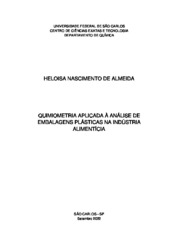| dc.contributor.author | Almeida, Heloísa Nascimento de | |
| dc.date.accessioned | 2022-10-14T08:08:00Z | |
| dc.date.available | 2022-10-14T08:08:00Z | |
| dc.date.issued | 2022-09-15 | |
| dc.identifier.citation | ALMEIDA, Heloísa Nascimento de. Quimiometria aplicada à análise de embalagens plásticas na indústria alimentícia. 2022. Trabalho de Conclusão de Curso (Graduação em Química) – Universidade Federal de São Carlos, São Carlos, 2022. Disponível em: https://repositorio.ufscar.br/handle/ufscar/16859. | * |
| dc.identifier.uri | https://repositorio.ufscar.br/handle/ufscar/16859 | |
| dc.description.abstract | Most of the packaging used in the food sector is produced in plastic materials that can be flexible or rigid. Rigid packaging such as high-density polyethylene is highlighted because they keep their shape independent of the characteristics of the stored product, however, under certain conditions, they are susceptible to deformation during storage, transport, and stacking. Therefore, in order to evaluate a possible decrease in the weight of the packaging aiming at productivity aspects, chemometric tools were used to understand how the storage temperature and the weight of the packaging affect in the resistance to compression and deformation. With the application of statistical tools such as Pearson coefficient, variance analysis and Tukey test it was possible to verify that the temperature and the weight of the packaging influence the mean of resistance, however only weight is a statistically significant factor for the mean of deformation. | eng |
| dc.description.sponsorship | Não recebi financiamento | por |
| dc.language.iso | por | por |
| dc.publisher | Universidade Federal de São Carlos | por |
| dc.rights | Attribution-NonCommercial-NoDerivs 3.0 Brazil | * |
| dc.rights.uri | http://creativecommons.org/licenses/by-nc-nd/3.0/br/ | * |
| dc.subject | Embalagens | por |
| dc.subject | Quimiometria | por |
| dc.subject | PEAD | por |
| dc.title | Quimiometria aplicada à análise de embalagens plásticas na indústria alimentícia | por |
| dc.title.alternative | Chemometrics applied to the analysis of plastic packaging in the food industry | eng |
| dc.type | TCC | por |
| dc.contributor.advisor1 | Pereira Filho, Edenir Rodrigues | |
| dc.contributor.advisor1Lattes | http://lattes.cnpq.br/3394181280355442 | por |
| dc.description.resumo | Grande parte das embalagens utilizadas no setor alimentício são produzidas em materiais plásticos, podendo ser flexíveis ou rígidas. As embalagens rígidas como as de polietileno de alta densidade recebem destaque, pois mantêm seu formato independente das características do produto armazenado, no entanto, em determinadas condições, estão suscetíveis à deformação durante estocagem, transporte e empilhamento. Diante disso, com o intuito de avaliar uma possível diminuição no peso da embalagem visando aspectos de produtividade, ferramentas quimiométricas foram utilizadas para entender como a temperatura de armazenagem e o peso da embalagem afetam na resistência a compressão e deformação. Com a aplicação de ferramentas estatísticas como coeficiente de Pearson, análise de variância e teste de Tukey foi possível verificar que a temperatura e o peso da embalagem influenciam na média da resistência, no entanto apenas o peso é um fator estatisticamente significativo para a média da deformação. | por |
| dc.publisher.initials | UFSCar | por |
| dc.subject.cnpq | CIENCIAS EXATAS E DA TERRA::QUIMICA::QUIMICA ANALITICA::INSTRUMENTACAO ANALITICA | por |
| dc.publisher.address | Câmpus São Carlos | por |
| dc.contributor.authorlattes | http://lattes.cnpq.br/6863627506038561 | por |
| dc.publisher.course | Química - Q | por |

